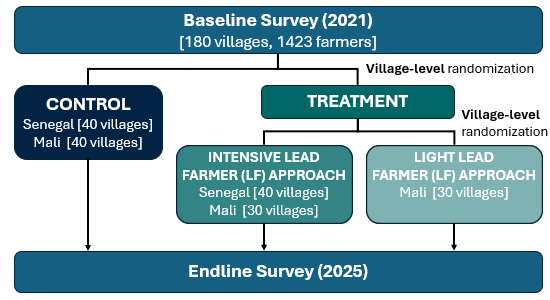Christian Grovermann1, Tesfamicheal Wossen2, Assane Beye3
1: Research Institute of Organic Agriculture (FiBL), Switzerland; 2: International Institute of Tropical Agriculture (IITA), Mali; 3: Université Cheikh Anta Diop (UCAD), Senegal
Preliminary findings are available as of July 2025 and reveal considerable impacts. The interventions employed a lead-farmer model to promote a suite of agroecological practices—including nitrogen-fixing shrub integration, composting, mulching, manure application, and legume-based rotations—aimed at improving dryland productivity and resilience. Specifically, two advisory modalities were tested: a high-intensity modality featuring continuous coaching and demonstration support for lead farmers, and a lighter-touch modality relying more on digital and print-based dissemination besides some limited demonstration for lead farmers. Across 180 villages and 1,423 households, both modalities significantly improved farmer awareness, exposure, and practice adoption.
Lead farmer outreach: After participation in field days organized by the project, each lead farmer established a CSL demonstration plot, attracting an average of 19 farmers per field day. Informal sharing extended total reach to about 40 farmers per lead farmer, underscoring a strong multiplier effect.
Practice adoption gains: Adoption of key practices—including shrub integration, mulching, and organic matter use (composting and animal manure)—increased significantly across both the intensive and lighter-touch advisory models. In Mali, both models led to substantial gains of 26 percentage points in shrub integration and around 40 percentage points in manure use. The intensive model further drove a 36-point increase in mulching, while the lighter-touch model showed more modest gains for mulching (8 points). In Senegal, the intensive model led to adoption gains of 24 points for mulching and 14 points for intercropping, while increases for shrub integration, composting, and manure ranged from 4 to 7 percentage points.
Both self-reported yield gain data (i.e., comparisons of yields with vs. without practices) and econometric analyses using measured plot-level data, including instrumental variable (IV) estimation, confirm that adoption of improved agroecological intensification practices led to significant gains in productivity and yield stability.
Impact on productivity: Adoption of improved practices resulted in substantial gains in both perceived and objectively measured yields. Farmers reported yield increases of 150 to over 300 kg/ha, particularly for manure, composting, and mulching, with consistent effects across millet and groundnut. These self-reported gains were supported by IV-based estimates from measured data, which indicated yield increases of 250–500 kg/ha for key practices.
Impact on yield stability: In addition to higher average yields, adoption of manure, mulching, composting, and shrub integration resulted in significantly reduced yield variance, indicating improved production stability and resilience to shocks.
Bundling amplifies impacts: Increasing the intensity of adoption through bundling generated synergistic effects, delivering both higher yields and improved yield stability. Households adopting two or more practices experienced the most pronounced improvements, with high bundlers showing the greatest gains in both productivity and resilience.
Overall, both advisory approaches delivered measurable gains in awareness, adoption, and productivity, with intensive support yielding stronger and more sustained impacts.
Advisory intensity matters: Structured training, demonstration plots, and peer learning consistently outperformed lighter-touch modalities, with knowledge diffusion extending well beyond direct lead farmers and village demo participants.
Bundled adoption is more effective: Simultaneous uptake of multiple practices produced synergistic benefits—improving average yields and yield stability. Farmer perceptions aligned closely with measured outcomes, strengthening credibility.
Scalability depends on delivery balance: While intensive models drive deeper impact, lighter-touch approaches offer promise for cost-effective scale-up—suggesting potential for tiered or hybrid delivery strategies.
While farmers expressed strong motivation to adopt agroecological practices, key constraints remain:
Limited access to planting material (esp. shrub seedlings): Cited by about 35% of farmers
Gaps in technical knowledge and skills: Reported by about 40% of farmers
Resource constraints: Including labor, time, and finances
These findings underscore that while intention and awareness are critical, effective scaling of shrub adoption will also require sustained efforts to address knowledge gaps, improve access to quality planting material, and reduce economic and logistical barriers that hinder adoption.

 tap and then scroll down to the Add to Home Screen command.
tap and then scroll down to the Add to Home Screen command.